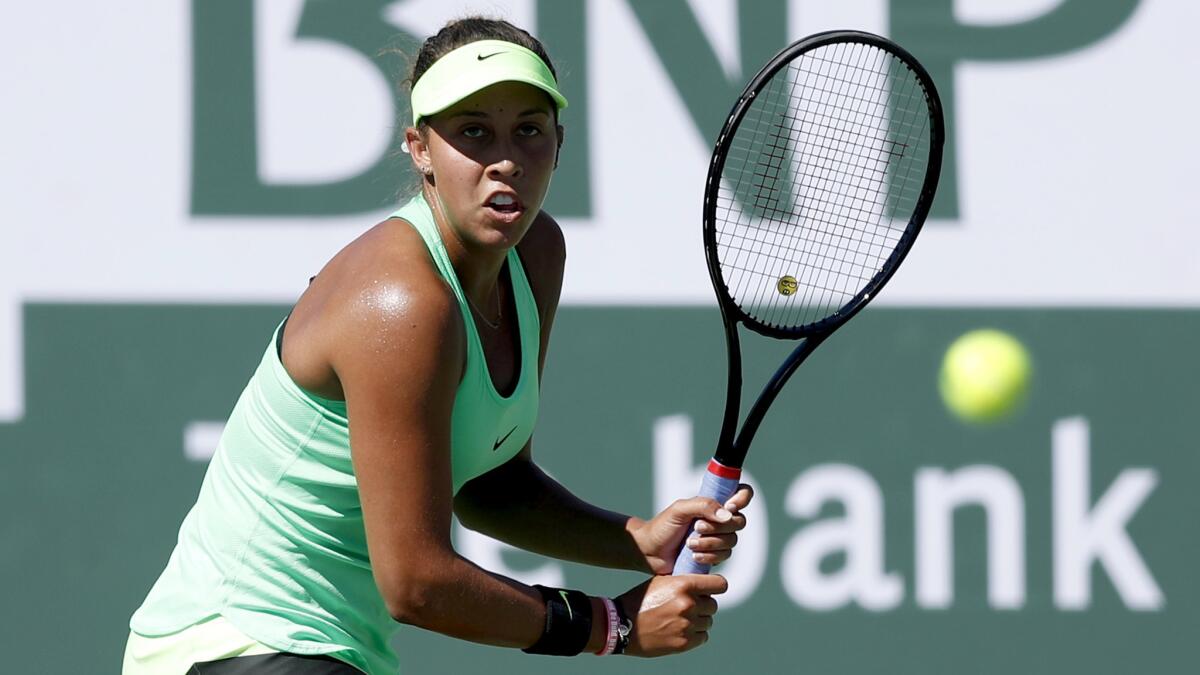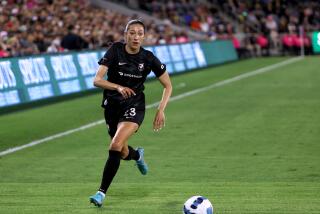Column: Madison Keys, back on the tour after surgery, finds the key to happiness has a lot to do with tennis

- Share via
Reporting from Indian Wells — Before she underwent arthroscopic surgery on her left wrist last Nov. 2, a few days after she had played in a season-ending tournament in Singapore, Madison Keys hadn’t taken a significant break from tennis for a while. A very long while.
“I don’t think I’ve had longer than, like, three weeks off since I was 4,” said Keys, who turned 22 last month.
She used some of her recovery time to enjoy a “normal” life and visit Mexico, Colorado and Hawaii, but after two months she realized she couldn’t distance herself from an essential truth: she passionately missed tennis. And tennis missed her, too, with her big game and outgoing personality and brilliant smile.
Her lengthy but necessary absence explained why she was near tears Saturday when she entered Stadium 3 at the BNP Paribas Open for her first match since October. Being away for so long also explained why her play got a little ragged in the second set before she completed a 6-1, 7-5 victory over Mariana Duque-Marino of Colombia, a triumph she punctuated with fist pumps and that nonstop smile.
“It’s just so great to be back,” said Keys, who is ranked No. 9 in the world and is seeded ninth here. “We do get to do what we love. I think that’s really special, and I think sometimes we get really caught up in the winning and the losing and rankings and all of that.
“And at the end of the day, we get to play a sport that we love for our jobs, and just this whole time has made me realize how truly blessed I am to be able to do that.”
Keys made a big breakthrough by reaching the Australian Open semifinals in 2015 and followed that in 2016 with a tour win at Birmingham, England, and round-of-16 appearances at all four Grand Slams. She cracked the top 10 for the first time and ended the year at No. 8, up from 18 at the end of 2015.
What no one knew was that she played the entire season with an injured wrist. Keys said Saturday she had hurt her non-dominant hand at the 2015 U.S. Open but “kind of just managed it for a while” and tried to tough it out without compromising her play.
“If anything, it made me play my game better, looking more for forehands, doing what I could, maybe not going for the winner down the line from 16 feet behind the baseline, playing a lot smarter,” she said. “More than anything, I think it made me a lot more mentally tough knowing it’s going to hurt, it’s going to be tough, but just wanting to make Singapore that badly, I was just going to do everything that I could to get there.”
Her initial plan was to have the surgery after the U.S. Open so she could be ready for this year’s Australian Open, but that changed once she qualified for the Singapore event. “To me, there is no way you’re going to get me off of a tennis court right now,” was her response. Delaying the procedure meant she wouldn’t be ready to compete in Australia, but her time away wasn’t a complete loss.
Aside from gaining perspective and appreciation for the sport, she worked out a way to reunite with her former coach, Lindsay Davenport, a tennis Hall of Fame member and three-time Grand Slam champion. They had collaborated for several years but parted when Davenport, the mother of four young children, pulled back because of family and other professional obligations. Keys, who lives in Florida, worked with Mats Wilander and Thomas Hogstedt before returning to Davenport, who lives in Southern California. When Davenport can’t work with her, Keys gets help from the U.S. Tennis Assn.
“I think we both came to the table knowing what I could give, what she could give, all of that,” Keys said. “I think we both know what to expect.”
Keys expected — and got — valuable help from Davenport on Saturday. She had taken a 5-1 lead in the second set but began to fade and became visibly frustrated by her unforced errors. Duque-Marino pounced, but Davenport helped calm Keys down and rebuild her confidence. “Even today at 5-4, she came out and said, ‘You’re good, you’re fine, you know,’” Keys said.
And she was fine, if a bit rusty now and then. But she might not have as much margin for error in her next match, against Naomi Osaka of Japan. Keys came back to defeat a jittery Osaka in the third round of last year’s U.S. Open after Osaka had led, 5-1, in the third set. “It’s going to be a tough match,” Keys said, though it can’t be as tough as playing with a bad wrist for as long as she did, an absence that ended joyfully on Saturday.
More to Read
Go beyond the scoreboard
Get the latest on L.A.'s teams in the daily Sports Report newsletter.
You may occasionally receive promotional content from the Los Angeles Times.










